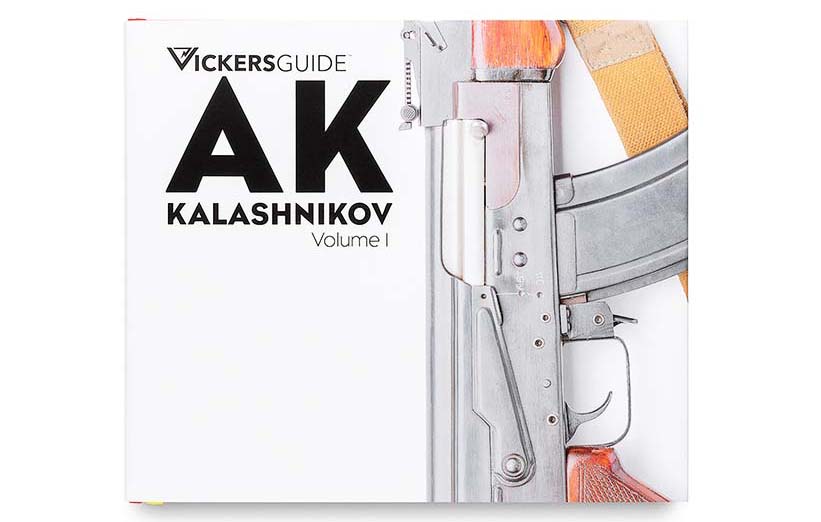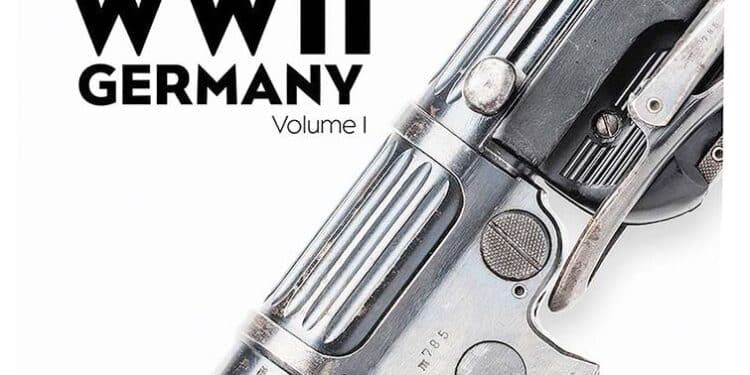By Dean Roxby

Vickers Guide: WWII Germany Vol I
- ISBN 978-0-9965032-3-5
- vickersguide.com
- 360 pages
- 13”x11” (approx.)
- Mott Lake Publishing
- P O Box 158294 Nashville, TN 37215
- mottlake.com

Vickers Guide: AK Kalashnikov Vol I
- ISBN 978-0-9965032-4-2
- vickersguide.com
- 360 pages
- 13”x11” (approx.)
- Mott Lake Publishing
- P O Box 158294 Nashville, TN 37215
- mottlake.com
As a lover of fine military books, I was immediately impressed by these wonderful books. They are everything that a premium quality, collector-grade coffee table book should be, without the “fluff.” Often, a book with great photos lacks technical expertise, simply relying on the photos to carry it. This most certainly is not the case with the Vickers Guide series. Author Larry Vickers definitely knows his stuff, as the list of his military and civilian awards and certifications attest.
Currently, there are five titles in the Vickers Guide series. In order of release, these are: 1911; AR-15, Vol. I; AR-15, Vol. II; WWII Germany, Vol. I; and AK Kalashnikov, Vol. I. This review will cover the two most recent titles.
Each title is available in three different versions or editions, these being the Standard, Signature and Limited Editions. The Signature Edition is hand-signed by Larry Vickers. The Limited Edition of each title is also hand-signed by Vickers, along with a personal handwritten message of your choosing. This numbered series is limited to 250 books (a mere 100 copies for the 1911 title).
Unfortunately, the vickersguide.com website now shows that all three versions of the AR-15 Vol. I are sold out. However, it also mentions the 1911 Standard Edition has been reprinted, so perhaps the AR book will be also.
These are large format books, measuring 13 inches wide, by 11 inches tall. And many of the photographs span across two pages, so the image is 26inx11in. The books are printed on premium quality paper, so the photos really pop. Each page feels a bit heavier than a typical page from other books. A nice touch is a ribbon page marker that is sewn into the binding. Not a huge deal, but it does add another touch of refinement to an already fine work.
Speaking of photography, the images featured are stunning. Photographer James Ripley has created a series of beautiful photos. The photos are studio quality images, more like high-end product photography than the usual distant, hard-to-make-out action shots in many books. Each photo is taken against a white background and is properly lit to avoid glare to bring out the finest details. Additional photography of mainly uniforms and other militaria was supplied by Jeff Demers for the WWII Germany Vol. I book.
Naturally, quality of this level does not come cheap. Starting at $95 for the Standard Edition (Signature Edition is $125, and the Limited Edition is $200), this is a big purchase for many people. However, books of this quality level do tend to increase in value once they are out of print. A quick browse on Amazon for other books of similar quality confirms this. Perhaps, if someone is having difficulty finding a suitable gift for you, a fine book is in order.
WWII Germany, Vol. I examines handguns, submachine guns, the K98k infantry rifle and sniper rifles. (The soon to be released Vol. II will cover semiauto rifles, select-fire rifles, belt-fed machine guns and “Last Ditch” weapons.)
The book begins with a sombre dedication to those lives lost due to WWII and the evil of the Third Reich. Vickers and Rupley want to be perfectly clear that displaying firearms and other historic militaria containing Swastikas and Nazi eagles does NOT imply any sort of support for such an evil regime.
The P08 Luger leads the collection of arms featured. Several fine specimens are displayed, representing different manufacturers, branches of service, grip types, etc., and then the P38, followed by foreign pistols put into German service.
Machine pistols and submachine guns pro-file some of the early attempts to create a practical SMG, culminating with the iconic MP38 and MP40 designs. The Soviet PPSh-41 is also discussed, due to so many being captured and put into German service.
The section on bolt-action rifles opens with a .22 rimfire training rifle, along with an article by guest author Robert Simpson explaining how the German military pulled a fast one on international inspectors. At the end of the First World War, the Treaty of Versailles put limits in place to prevent Germany from re-arming. By making “commercial sporting target” rifles, Germany was able to rebuild her arms industry and offer marksmanship training to huge numbers of men prior to WWII.
The K98k infantry rifle is studied in detail, comparing specimens from pre-war, early-war and late-war. Ian McCollum, of Forgotten Weapons fame, wrote a detailed essay on this subject. He contributed several articles, including a piece about waffenamts and proof marks.
Sniper rifles based upon the K98k are given a separate section. Also included is a look at Soviet sniper rifles. As with the PPSh-41 mentioned above, the rationale is that so many rifles were captured and used, it is valid to include the Mosin-Nagant as German equipment.
AK Kalashnikov Vol. I deals exclusively with the 7.62×39 caliber AK rifles, so we can probably expect a second volume on 5.45×39 in the future. In this first volume, the AK series is covered, from the earliest AK-47, up to the modern AK-203 and AK-15 variants. (It is worth noting that guest author, N.R. Jenzen-Jones, Director at Armament Research Services, points out that the name AK-47 actually only applies to the early “trials” guns, prototypes that took part in the selection process. The production service rifles are correctly named “AK” only, followed by the “AKM.”)
Speaking of the true AK-47 trials guns, the authors were given access to two early trials guns; one fixed stock and one underfolder. Again, Rupley was able to use his masterful photography skills to capture details of these rare items. Also featured is a gun presented to Soviet dictator Joseph Stalin.
Several guest authors contributed articles on specific subjects. Ian McCollum wrote a piece on the progression of the Type 1, 2 and 3 receiver differences. He also contributed an article comparing and contrasting the German Sturmgewehr to the AK design. Maxim Popen-ker, founder of worldguns.ru wrote about the influence German designers may or may not have had on the AK. (He believes the German influence was minimal.) Rob Stott, publisher of the AK-47 Catalog Volume I, covered Type 2 production, as well as Chinese factory codes.
After covering the USSR and Russian models, the many foreign-produced variants are examined. Countries covered include Albania, Bulgaria, China, DDR (East Germany), Egypt, Hungary, Iraq, North Korea, Pakistan (Khyber Pass knock-offs), Poland, Romania, Vietnam and former Yugoslavia. There are many small but significant differences in these various models, detailed both in text and photos.
Several pages are given to cover the many variants of magazines fielded over the years, both Soviet and foreign. Guest author Brandon LeLeux wrote a three-page history of AK mags, describing steel, aluminum and polymer types, followed by five pages of comparison photos.
Based on the two titles I have seen, I predict great success for this series. And I hope the authors continue to add more books. Using the same format for WWII-era U.S., British Commonwealth and Soviet arms would make an amazing collection.
| This article first appeared in Small Arms Review V23N7 (AUG/SEPT 2019) |












